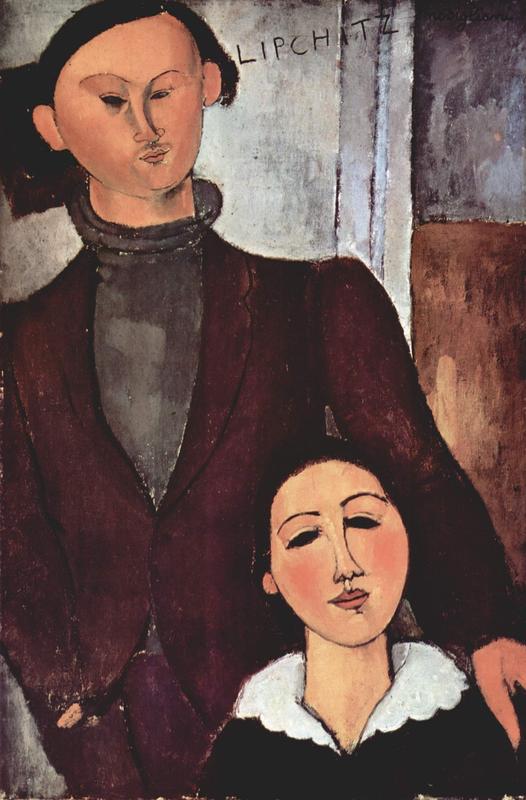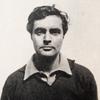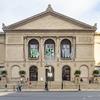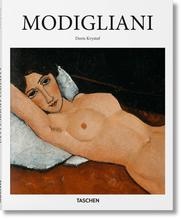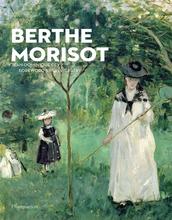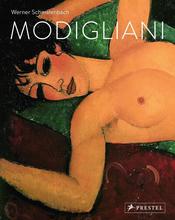More about Jacques and Berthe Lipchitz
- All
- Info
- Shop

Sr. Contributor
Amedeo Modigliani helped to establish a Parisian community of Jewish artists that supported one another.
Modigliani knew Montparnasse was special when he moved there in 1906, but I don’t think he realized just how important the neighborhood would become for émigrés like him in the coming years. In just three years, Montparnasse became a hub for the avant-garde and ultimately held this status for nearly thirty years. A taste for modernity wasn’t the only thing that these artists shared. Many of them, including the Lithuanian sculptor Jacques Lipchitz and the Russian painter Chaim Soutine, were also Jewish.
Supporting artistic ventures was an important element of belonging to the Montparnasse community. Conversations, criticism, and commissions abounded. It was the right time and place for a group of young artists to stake their claim in the long trajectory of art history. Lipchitz, who arrived in Paris as a refugee, thrived as Cubism was taking holA Sunday Afternoon on the Island of La Grande Jatted of the city. He was an inventive sculptor who successfully translated the principles of Cubist painting into three-dimensional creations. Lipchitz commissioned this portrait from his friend and co-conspirator to commemorate his recent marriage to the Russian poet Berthe Kitrosser.
The portrait was also a way for Modigliani to make some money, which he needed badly. Interestingly, this painting is one of only three double portraits that he ever made. But this unfamiliarity didn’t faze Modigliani. After making about twenty drawings on the first day, he declared the painting finished on the second. Despite this claim of completion, Lipchitz convinced his friend to keep working on the portrait. This was a sly, yet generous, way for Lipchitz to give Modigliani more money for the portrait, which was paid per sitting. Modigliani agreed to continue working on the painting for two weeks, even though he believed that he would ultimately ruin it. Notorious for his speed, this was probably the longest time Modigliani ever spent on a single artwork.
This wasn’t the only time Modigliani shortchanged himself when selling his work to friends. Lipchitz bought four nudes by Modigliani for a measly 500 francs. A true bohemian, Modigliani was also known to paint portraits for some food or a few drinks. Modigliani’s work only really started selling after his untimely death in 1920. Decades later, a Modigliani nude fetched $157.2 million at a 2018 auction, making it the most expensive painting ever sold at Sotheby’s. I wonder how many cheap drinks at a Montparnasse cafe that would have equated to...
Lipchitz later exchanged this portrait with art historian and collector Léonce Rosenberg, who later sold it to Frederick Bartlett Clay Bartlett, a Chicago artist and art collector, and his wife, Helen Birch Bartlett. Together, they were some of the first Americans to collect Post-Impressionist artworks. To honor Helen’s death in 1925, Frederick donated a treasure trove of art that has shaped the Art Institute of Chicago’s collection. In addition to this Modigliani, he also donated Georges Seurat’s famous A Sunday Afternoon on the Island of La Grande Jatte and Pablo Picasso'sequally well-known The Old Guitarist. After Frederick died in 1956, his second wife donated funds to build a gallery dedicated to this group of artworks, which is known as the Helen Birch Bartlett Memorial Collection and is worth a visit if you find yourself in the Windy City.
Sources
- ARTNews. “From the Archives: Jacques Lipchitz Remembers Amedeo Modigliani, in 1951.” Retrospective. 15 December 2017. https://www.artnews.com/art-news/retrospective/archives-jacques-lipchit…. Accessed 5 August 2020.
- Dobrzynski, Judith H. “Evelyn Bartlett, Patron of Art And Ornament, Dies at 109.” Arts. The New York Times. 3 July 1997. https://www.nytimes.com/1997/07/03/arts/evelyn-bartlett-patron-of-art-a…. Accessed 5 August 2020.
- Sotheby’s. “At $157.2 Million, Modigliani’s Greatest Nude Is Also the Most Expensive Painting Ever Sold at Sotheby’s.” Impressionist & Modern Art. 14 May 2018. https://www.sothebys.com/en/articles/at-157-2-million-modiglianis-great…
- The Art Story. “Jacques Lipchitz.” Artists. https://www.theartstory.org/artist/lipchitz-jacques/. Accessed 5 August 2020.
- Art Institute of Chicago. “Jacques and Berthe Lipchitz.” The Collection. https://www.artic.edu/artworks/27987/jacques-and-berthe-lipchitz. Accessed 5 August 2020.
Featured Content
Here is what Wikipedia says about Jacques and Berthe Lipchitz
Jacques and Berthe Lipchitz is a 1916 oil on canvas painting by Amedeo Modigliani. It depicts Modigliani's friend, the sculptor Jacques Lipchitz, standing alongside his seated wife Berthe.
Modigliani and Lipchitz had each moved to France at a young age, were both from Jewish backgrounds, and became close friends who frequented the same artistic circles in Paris. Despite their commonalities, there were marked differences: Lipchitz exemplified artistic industriousness while Modigliani was given to bohemian dissolution.
Before painting Jacques and Berthe Lipchitz Modigliani made a series of preparatory drawings, of which five survive: two of Lipchitz, two of Berthe, and one of them together in the resolved composition. Lipchitz described the painting's development years later:
In 1916, having just signed a contract with Leonce Rosenberg, the dealer, I had a little money. I was also newly married, and my wife and I decided to ask Modigliani to make our portrait. "My price is ten francs a sitting and a little alcohol, you know," he replied when I asked him to do it. He came the next day and made a lot of preliminary drawings, one right after the other, with tremendous speed and precision. ... Finally a pose was decided upon— a pose inspired by our wedding photograph.
The following day at one o'clock, Modigliani came with an old canvas and his box of painting materials, and we began to pose. I see him so clearly even now— sitting in front of his canvas which he had put on a chair, working quietly, interrupting only now and then to take a gulp of alcohol from the bottle standing nearby. ... By the end of the day he said "Well, I guess it's finished."
Lipchitz was uncomfortable accepting the painting for merely ten francs, and made excuses in order for Modigliani to continue working on the portrait. "You know", I said, "we sculptors like more substance." "Well," he answered, "if you want me to spoil it, I can continue." The portrait occupied Modigliani for nearly two weeks, "probably the longest time he ever worked on one painting."

One of only two double portraits painted by Modigliani, Jacques and Berthe Lipchitz has been noted for its complex and enigmatic study of contrasting personalities. Lipchitz is shown with his wife Berthe Kitrosser, a Russian poet, in their Paris apartment that had previously been the home of the sculptor Constantin Brâncuși. Posed in front of an abstracted architectural interior, Lipchitz is handsomely dressed, and stands casually with one hand on Berthe's shoulder. Their mask-like faces have encouraged varied readings; Berthe's gentle sensuality, her large eyes and lips and graceful neck, have been seen to offer a striking contrast to Lipchitz's self-pride, his small eyes and mouth and "wickedly twisted nose" combining to satirical effect. For art historian and curator Mason Klein, Berthe's face is bland and bourgeois, her frilly collar and pert nose suggesting haughtiness, while Lipchitz stands above her, domineering and protective.
Modigliani biographer Werner Schmalenbach compared Jacques and Berthe Lipchitz to the artist's Bride and Groom of 1915, and noted the development away from a purely formal depiction of 'types' to a greater interest in the characterization of individuals. This difference in the two works is consistent with an evolution in Modigliani's drawing and painting toward increased refinement.
After Modigliani died in 1920 Lipchitz crafted his death mask, making twelve plaster molds for Modigliani's friends and family. Soon thereafter Lipchitz traded the painting to his dealer in exchange for the return of sculptures "which I no longer felt were representative." The painting was purchased in 1922, and entered the Art Institute of Chicago in 1926 as part of the Helen Birch Bartlett Memorial Collection.
Check out the full Wikipedia article about Jacques and Berthe Lipchitz

